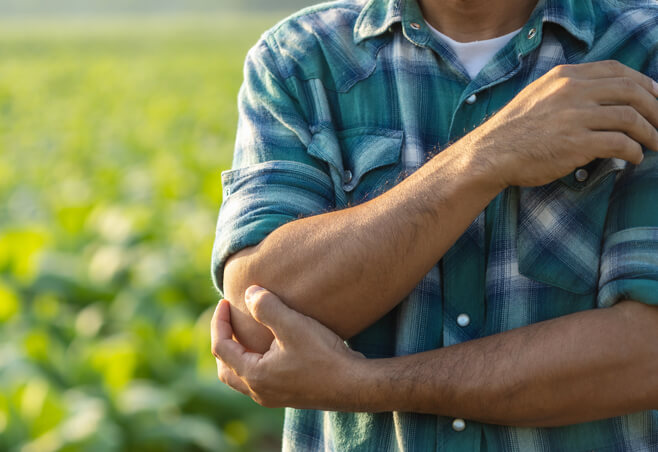UCL injuries
Ulnar collateral ligament
The ulnar collateral ligament (UCL) is a ligament located on the inner side of your elbow, which supports the elbow joint. This tendon links the upper arm to the forearm which helps to stabilize and support your arm when performing any type of movement, such as throwing a ball or swinging a bat. Constant motion and repetitive strain and trauma can lead the UCL to become stretched or even tear over time.
Sometimes the ligament can be repaired with suture augmentation rather than needing a full reconstruction.
Anatomy
The elbow is commonly known as a hinge joint since it bends and straightens up similar a hinge. Within the elbow are several ligaments, which are soft tissues that bind to the bones of the arm together. The elbow is comprised of the following bones and ligaments:
- Humerus – The bone of the upper arm
- Ulna – The larger bone of the forearm located on the opposite side of the thumb
- Radius – The smaller bone of the forearm located on the same side as the thumb
- Lateral collateral ligament – The ligament located on the outside of the elbow
- Ulnar collateral ligament (UCL) – The ligament that is located on the side of the elbow that aligns with the body. Triangular in shape, the UCL is also known as medial collateral ligament. The UCL also has posterior bundle, an anterior bundle, and a transverse ligament.
The lateral collateral ligament and ulnar collateral ligament connect with the humerus and the ulna and allow for movement and fluid motion throughout the elbow.
About
The ulnar collateral ligament injury can be most commonly seen in athletes, due to constant motion and repetitive strain and trauma to the elbow, which can cause stretching, microtears, and frays. The UCL can also be torn when there is a dislocation or injury to the joint. Falling onto an outstretched arm can lead the ligament to be ruptured or even pulled off the humerus bone, causing small chipping of the bone. This type of injury is called an avulsion fracture. This diagnosis is rare in most medical cases but is followed by elbow displacement or fracture.
Symptoms
Symptoms of an injured ulnar collateral ligament will depend on the severity of the case, but general indicators include:
- Pain and tenderness along the elbow and arm
- Soreness in the elbow joint
- Swelling of the joint
- Tingling or numbness throughout the inner elbow, fingers, and arm
- A sense of instability of the elbow
- The sense of laxity or looseness of the elbow
- Decreased ability to toss throw or catch an object
- Irritation of the “funny” bone
- Popping, cracking and grinding of the elbow

Diagnosis
Your Florida Orthopaedic Institute physician will evaluate your symptoms and determine the cause of pain. Your history and symptoms help diagnose an ulnar collateral ligament injury. A physical examination from the shoulder to the elbow is taken, looking for areas of both tightness and looseness. A valgus stress test can be given, which assesses the instability of the elbow. For this test, the physician applies force to the inside of the elbow as the joint flexes. X-rays are taken to examine for breaks and loose fragments. MRI scans with “contrast dye” are used to determine if a ligamentous rupture has occurred. Additionally, ultrasound or CT scans can further diagnose the injury.
Treatment
Your physician will discuss all options for your treatment to determine which is the best for your needs. If surgery is required, an ulnar collateral ligament reconstruction, also known as a Tommy John surgery, will be done to repair a UCL injury. The reconstruction surgery will involve harvesting a tendon from the patient’s body or a donor, known as a graft.
Grafts are typically taken from one of the three following areas:
- The big toe extensor tendon
- The palmaris longus tendon from the forearm
- The hamstring tendon
This tendon will then be attached in place to act as a new UCL, also known as the docking technique.
Nonsurgical treatments
Florida Orthopaedic Institute physicians provide all nonsurgical options to a patient before surgery is recommended. If the pain is not as severe, non-surgical treatment methods may be used to reduce the pain of the injured ulnar collateral ligament. These may include:
- Physical therapy
- Rehabilitation
- Icing of joints
- PRP may be used as a nonsurgical treatment and adjunct at time of surgery
Recovery
Following treatment, a series of motion and strengthening exercises are begun. As swelling and pain subside, joint mobility begins to return. Physical therapy and rehab are started. Athletes commonly begin gradual throwing programs to get back on track. Total sports participation can be expected within one to three months. Patients should follow their physician’s care instructions and if severe pain persists, follow up to determine if additional treatment is required.
Videos
Related specialties
- Arthroscopic Debridement of the Elbow
- Aspiration of the Olecranon Bursa
- Cubital Tunnel Syndrome
- Elbow Bursitis
- Elbow Injuries & Inner Elbow Pain in Throwing Athletes
- Golfer's Elbow
- Growth Plate Injuries of the Elbow
- Hyperextension Injury of the Elbow
- Little Leaguer's Elbow (Medial Apophysitis)
- Olecranon Stress Fractures
- Radial Tunnel Syndrome
- Tennis Elbow Treatment
- Tricep Pain & Tendonitis
- Valgus Extension Overload
